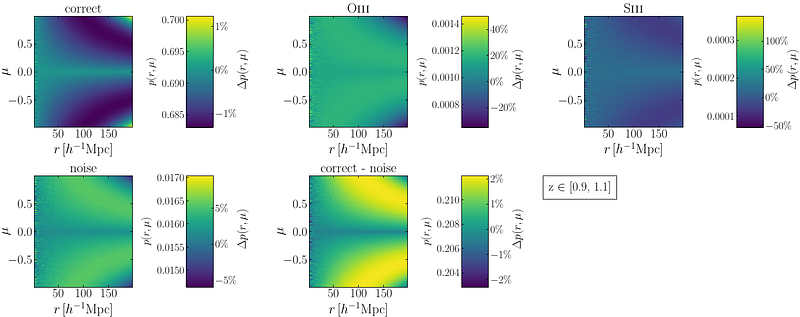Euclid preparation. The impact of redshift interlopers on the two-point correlation function analysis

Euclid preparation. The impact of redshift interlopers on the two-point correlation function analysis
Euclid Collaboration, I. Risso, A. Veropalumbo, E. Branchini, E. Maragliano, S. de la Torre, E. Sarpa, P. Monaco, B. R. Granett, S. Lee, G. E. Addison, S. Bruton, C. Carbone, G. Lavaux, K. Markovic, K. McCarthy, G. Parimbelli, F. Passalacqua, W. J. Percival, C. Scarlata, E. Sefusatti, Y. Wang, M. Bonici, F. Oppizzi, N. Aghanim, B. Altieri, A. Amara, S. Andreon, N. Auricchio, C. Baccigalupi, M. Baldi, A. Balestra, S. Bardelli, P. Battaglia, A. Biviano, A. Bonchi, D. Bonino, M. Brescia, J. Brinchmann, S. Camera, G. Cañas-Herrera, V. Capobianco, V. F. Cardone, J. Carretero, S. Casas, M. Castellano, G. Castignani, S. Cavuoti, K. C. Chambers, A. Cimatti, C. Colodro-Conde, G. Congedo, C. J. Conselice, L. Conversi, Y. Copin, F. Courbin, H. M. Courtois, M. Crocce, A. Da Silva, H. Degaudenzi, G. De Lucia, A. M. Di Giorgio, H. Dole, M. Douspis, F. Dubath, C. A. J. Duncan, X. Dupac, S. Dusini, S. Escoffier, M. Farina, R. Farinelli, F. Faustini, S. Ferriol, F. Finelli, S. Fotopoulou, N. Fourmanoit, M. Frailis, E. Franceschi, M. Fumana, S. Galeotta, K. George, W. Gillard, B. Gillis, C. Giocoli, J. Gracia-Carpio, A. Grazian, F. Grupp, L. Guzzo, S. V. H. Haugan, W. Holmes, F. Hormuth, A. Hornstrup, P. Hudelot, K. Jahnke, M. Jhabvala, B. Joachimi, E. Keihänen, S. Kermiche, A. Kiessling, M. Kilbinger, B. Kubik, M. Kümmel, M. Kunz, H. Kurki-Suonio, A. M. C. Le Brun, P. Liebing, S. Ligori, P. B. Lilje, V. Lindholm, I. Lloro, G. Mainetti, D. Maino, E. Maiorano, O. Mansutti, S. Marcin, O. Marggraf, M. Martinelli, N. Martinet, F. Marulli, R. Massey, S. Maurogordato, E. Medinaceli, S. Mei, M. Melchior, Y. Mellier, M. Meneghetti, E. Merlin, G. Meylan, A. Mora, M. Moresco, L. Moscardini, R. Nakajima, C. Neissner, S. -M. Niemi, J. W. Nightingale, C. Padilla, S. Paltani, F. Pasian, K. Pedersen, V. Pettorino, S. Pires, G. Polenta, M. Poncet, L. A. Popa, L. Pozzetti, F. Raison, R. Rebolo, A. Renzi, J. Rhodes, G. Riccio, E. Romelli, M. Roncarelli, E. Rossetti, R. Saglia, Z. Sakr, D. Sapone, B. Sartoris, J. A. Schewtschenko, P. Schneider, T. Schrabback, M. Scodeggio, A. Secroun, G. Seidel, M. Seiffert, S. Serrano, P. Simon, C. Sirignano, G. Sirri, L. Stanco, J. Steinwagner, C. Surace, P. Tallada-Crespí, D. Tavagnacco, A. N. Taylor, I. Tereno, N. Tessore, S. Toft, R. Toledo-Moreo, F. Torradeflot, I. Tutusaus, L. Valenziano, J. Valiviita, T. Vassallo, G. Verdoes Kleijn, D. Vibert, J. Weller, G. Zamorani, F. M. Zerbi, E. Zucca, V. Allevato, M. Ballardini, M. Bolzonella, E. Bozzo, C. Burigana, R. Cabanac, A. Cappi, D. Di Ferdinando, J. A. Escartin Vigo, L. Gabarra, W. G. Hartley, J. Martín-Fleitas, S. Matthew, N. Mauri, R. B. Metcalf, A. Pezzotta, M. Pöntinen, C. Porciani, V. Scottez, M. Sereno, M. Tenti, M. Viel, M. Wiesmann, Y. Akrami, S. Alvi, I. T. Andika, M. Archidiacono, F. Atrio-Barandela, S. Avila, A. Balaguera-Antolinez, C. Benoist, D. Bertacca, M. Bethermin, L. Blot, H. Böhringer, S. Borgani, M. L. Brown, A. Calabro, B. Camacho Quevedo, F. Caro, C. S. Carvalho, T. Castro, F. Cogato, A. R. Cooray, O. Cucciati, S. Davini, F. De Paolis, G. Desprez, A. Díaz-Sánchez, J. J. Diaz, S. Di Domizio, J. M. Diego, P. Dimauro, A. Enia, Y. Fang, A. G. Ferrari, A. Finoguenov, A. Fontana, A. Franco, K. Ganga, J. García-Bellido, T. Gasparetto, V. Gautard, E. Gaztanaga, F. Giacomini, F. Gianotti, G. Gozaliasl, M. Guidi, C. M. Gutierrez, A. Hall, S. Hemmati, C. Hernández-Monteagudo, H. Hildebrandt, J. Hjorth, S. Joudaki, J. J. E. Kajava, Y. Kang, V. Kansal, D. Karagiannis, K. Kiiveri, C. C. Kirkpatrick, S. Kruk, V. Le Brun, J. Le Graet, L. Legrand, M. Lembo, F. Lepori, G. Leroy, G. F. Lesci, L. Leuzzi, T. I. Liaudat, A. Loureiro, J. Macias-Perez, M. Magliocchetti, F. Mannucci, R. Maoli, C. J. A. P. Martins, L. Maurin, M. Miluzio, C. Moretti, G. Morgante, S. Nadathur, K. Naidoo, A. Navarro-Alsina, K. Paterson, L. Patrizii, A. Pisani, D. Potter, S. Quai, M. Radovich, P. -F. Rocci, S. Sacquegna, M. Sahlén, D. B. Sanders, A. Schneider, D. Sciotti, E. Sellentin, L. C. Smith, J. G. Sorce, K. Tanidis, C. Tao, G. Testera, R. Teyssier, S. Tosi, A. Troja, M. Tucci, C. Valieri, A. Venhola, D. Vergani, G. Verza, N. A. Walton
AbstractThe Euclid survey aims to measure the spectroscopic redshift of emission-line galaxies by identifying the H$\,{\alpha}$ line in their slitless spectra. This method is sensitive to the signal-to-noise ratio of the line, as noise fluctuations or other strong emission lines can be misidentified as H$\,{\alpha}$, depending on redshift. These effects lead to catastrophic redshift errors and the inclusion of interlopers in the sample. We forecast the impact of such redshift errors on galaxy clustering measurements. In particular, we study the effect of interloper contamination on the two-point correlation function (2PCF), the growth rate of structures, and the Alcock-Paczynski (AP) parameters. We analyze 1000 synthetic spectroscopic catalogues, the EuclidLargeMocks, designed to match the area and selection function of the Data Release 1 (DR1) sample. We estimate the 2PCF of the contaminated catalogues, isolating contributions from correctly identified galaxies and from interlopers. We explore different models with increasing complexity to describe the measured 2PCF at fixed cosmology. Finally, we perform a cosmological inference and evaluate the systematic error on the inferred $f\sigma_8$, $\alpha_{\parallel}$ and $\alpha_{\perp}$ values associated with different models. Our results demonstrate that a minimal modelling approach, which only accounts for an attenuation of the clustering signal regardless of the type of contaminants, is sufficient to recover the correct values of $f\sigma_8$, $\alpha_{\parallel}$, and $\alpha_{\perp}$ at DR1. The accuracy and precision of the estimated AP parameters are largely insensitive to the presence of interlopers. The adoption of a minimal model induces a 1%-3% systematic error on the growth rate of structure estimation, depending on the redshift. However, this error remains smaller than the statistical error expected for the Euclid DR1 analysis.